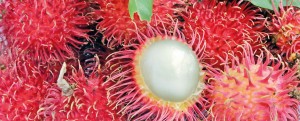It’s July, the time for juicy Rambutan
Despite its humble nutritional value the fruit boasts of several health benefits
It is July; it is the season for rambutan. Red and yellow heaps of this luscious fruit displayed neatly and beautifully can be seen by the roadside and in supermarkets. Though now grown in many parts of the mid- country and low- country wet zone of Sri Lanka, Malwana in the Gampaha district is synonymous with rambutan. Of the several varieties, ‘Malwana special’ with a deep red skin is signalled as the best variety and is sold at a premium price. This is believed to be a hybrid of a Malayan variety. The more orange traditional Sri Lankan variety is called “Val rambutan.” The Malaysian yellow is yet another common variety. The flesh that separates easily from the seed distinguishes the more desirable varieties.

Juicy mouthful: Rambutan. Pic by M.A. Pushpa Kumara
Rambutan (Nephelium lappaceum), is a tropical fruit native to the Malayan archipelago and belongs to the family Sapindaceae. The word rambutan is derived from the Malay word rambut meaning “hair”, a reference to the numerous hairy bristle like protuberances of the fruit. The fruits are oval or round in shape and the size of a small hen’s egg. The skin is parchment-like and hides the white translucent flesh that clings on to a woody seed. The flesh boasts of a wonderfully fresh, delightful flavour, similar to grapes and lychees.
The rambutan season usually comes once a year but at times luck strikes and there can be a dual season. The fruits are borne on clusters of ten to twelve. An average tree may produce 5,000 to 6,000 fruits with some trees producing as many as 10,000 fruits a year. The fruits must ripen on the tree. Once picked, rambutans do not ripen, they just rot. Harvesting is usually done over a four to seven week period.
When you are buying rambutans, look for the fresh ones that are bright red or yellow with firm spines. If you’re able to find those that are still attached to the branch, go for them as they have higher culinary and nutritional value. The fruits can be stored at room temperature for a couple of days. Refrigerating the fruits, wrapped in a paper towel or stored in a perforated plastic bag gives them a life span of about a week.
Most of the flavour and the nutritional value of the fruit are retained when eaten fresh. But you can also slice up the flesh and use in fruit salads and cocktails or turn into jams, chutneys, ice creams, smoothies and sorbets or use in sauces for chicken and seafood dishes. Doused in sugar syrup, they also make great toppings for cakes and pastries.Rambutan juice is also good, enlivened with some vanilla or cinnamon.
Nutritional benefits
The fruit is high in sugar, mainly sucrose and fructose and low in calories. It is a good source of dietary fibre, vitamin C, copper and manganese. It also contains moderate amounts of vitamin B2, B3,calcium, iron and phosphorous.
Generates red and white blood cells
Compared to other fruits, rambutan is a good source of copper, which is vital for the production of red and white blood cells. Although our body requires only a small amount of copper, this trace mineral is crucial. The manganese in the fruit is essential for the production of enzymes and their activation.
Good for anemia
The iron in rambutan is beneficial for the human body, as iron promotes the right level of oxygen in your body, which can help prevent fatigue and dizziness that come with anaemia, a condition occurring from low iron.
Boosts energy
Juice made from rambutan is an excellent energy drink as the fruit is rich in sucrose and fructose which helps give an instant energy boost. The high water content of the fruit helps quench thirst and bring back lost energy. It is thus highly suitable for runners and other sports players.
Helps clean kidneys
Another highly valuable function of rambutan is that it assists in filtering out waste from the kidneys with the help of the phosphorous present in the fruit. Besides, phosphorous is essential for the growth, repair and maintenance of all tissues and cells.
Reduces unwanted fat
As the fruit is high in fibre and low on calories rambutan is an excellent weight-loss food. Moreover, the high water content decreases hunger episodes significantly.
Relieves constipation
Rambutan helps relieve constipation due to the high dietary fibre content that adds bulk to stools encouraging their elimination.
Strengthens bones
Rambutan contains calcium, and phosphorus that work in tandem to strengthen bones and teeth. Healthier bones lead to stable growth and reduced chances of fractures and other bone diseases.
Improves sperm quality
Eating rambutan could be a big help to people with low sperm count, or who have weak sperm cells. Vitamin C, which the rambutan fruit is rich in, can also be very important for sperm development.
Increases immunity and prevents diseases
The high vitamin C content in the fruit also provides increased immunity from infections by helping strengthen our body’s defence mechanism. Moreover, vitamin C helps in the absorption of iron and copper.
Treats common illnesses
Rambutan is good for treating common illnesses such as headache, thrush, loose bowel movement and other stomach related problems. It is reported that the fruit can ease the pain of migraine as well.
Helps in hair care
The high copper content in rambutan helps prevent hair loss, intensifies hair colour, and prevents premature graying. Copper is also crucial for healthy hair growth.
Makes skin better and younger
Rambutan helps in hydrating your skin and making it soft and supple. The vitamin C and manganese, two potent antioxidants in the fruit promote healthy, youthful skin by scavenging free radicals and by enhancing your body’s ability to produce new collagen.
So there you are, despite the humble nutritional value of rambutan, the fruit boasts of several impressive health benefits.


